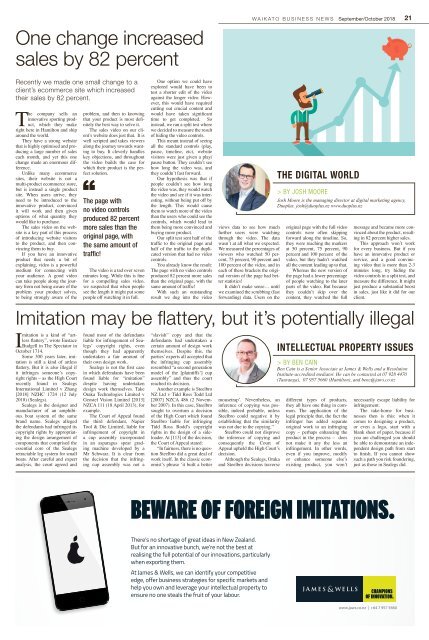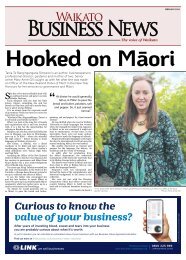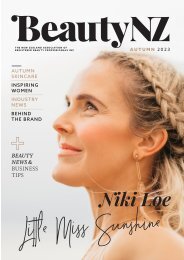Waikato Business News September/October 2018
Waikato Business News has for a quarter of a century been the voice of the region’s business community, a business community with a very real commitment to innovation and an ethos of co-operation.
Waikato Business News has for a quarter of a century been the voice of the region’s business community, a business community with a very real commitment to innovation and an ethos of co-operation.
Create successful ePaper yourself
Turn your PDF publications into a flip-book with our unique Google optimized e-Paper software.
WAIKATO BUSINESS NEWS <strong>September</strong>/<strong>October</strong> <strong>2018</strong> 21<br />
One change increased<br />
sales by 82 percent<br />
Recently we made one small change to a<br />
client’s ecommerce site which increased<br />
their sales by 82 percent.<br />
The company sells an<br />
innovative sporting product,<br />
which they make<br />
right here in Hamilton and ship<br />
around the world.<br />
They have a strong website<br />
that is highly optimised and producing<br />
a large number of sales<br />
each month, and yet this one<br />
change made an enormous difference.<br />
Unlike many ecommerce<br />
sites, their website is not a<br />
multi-product ecommerce store,<br />
but is instead a single product<br />
site. When users arrive, they<br />
need to be introduced to the<br />
innovative product, convinced<br />
it will work and then given<br />
options of what quantity they<br />
would like to purchase.<br />
The sales video on the website<br />
is a key part of this process<br />
of introducing website visitors<br />
to the product, and then convincing<br />
them to buy.<br />
If you have an innovative<br />
product that needs a bit of<br />
explaining, video is a powerful<br />
medium for connecting with<br />
your audience. A good video<br />
can take people along the journey<br />
from not being aware of the<br />
problem your product solves,<br />
to being strongly aware of the<br />
problem, and then to knowing<br />
that your product is most definitely<br />
the best way to solve it.<br />
The sales video on our client’s<br />
website does just that. It is<br />
well scripted and takes viewers<br />
along the journey towards wanting<br />
to buy. It cleverly handles<br />
key objections, and throughout<br />
the video builds the case for<br />
which their product is the perfect<br />
solution.<br />
The page with<br />
no video controls<br />
produced 82 percent<br />
more sales than the<br />
original page, with<br />
the same amount of<br />
traffic!<br />
The video is a tad over seven<br />
minutes long. While this is fine<br />
for a compelling sales video,<br />
we suspected that when people<br />
see the length it might put some<br />
people off watching it in full.<br />
One option we could have<br />
explored would have been to<br />
test a shorter edit of the video<br />
against the longer video. However,<br />
this would have required<br />
cutting out crucial content and<br />
would have taken significant<br />
time to get completed. So<br />
instead, we ran a split test where<br />
we decided to measure the result<br />
of hiding the video controls.<br />
This meant instead of seeing<br />
all the standard controls (play,<br />
pause, timeline, etc), website<br />
visitors were just given a play/<br />
pause button. They couldn’t see<br />
how long the video was, and<br />
they couldn’t fast forward.<br />
Our hypothesis was that if<br />
people couldn’t see how long<br />
the video was, they would watch<br />
the video and see if it was interesting,<br />
without being put off by<br />
the length. This would cause<br />
them to watch more of the video<br />
than the users who could see the<br />
controls, which would lead to<br />
them being more convinced and<br />
buying more product.<br />
Our split test sent half of the<br />
traffic to the original page and<br />
half of the traffic to the duplicated<br />
version that had no video<br />
controls.<br />
You already know the result:<br />
The page with no video controls<br />
produced 82 percent more sales<br />
than the original page, with the<br />
same amount of traffic!<br />
With such an outstanding<br />
result we dug into the video<br />
views data to see how much<br />
further users were watching<br />
through the video. The data<br />
wasn’t at all what we expected.<br />
We measured the percentages of<br />
viewers who watched 50 percent,<br />
75 percent, 90 percent and<br />
100 percent of the video, and in<br />
each of these brackets the original<br />
version of the page had better<br />
statistics!<br />
It didn’t make sense… until<br />
we examined the scrubbing (fast<br />
forwarding) data. Users on the<br />
THE DIGITAL WORLD<br />
> BY JOSH MOORE<br />
Josh Moore is the managing director at digital marketing agency,<br />
Duoplus. josh@duoplus.nz www.duoplus.nz<br />
original page with the full video<br />
controls were often skipping<br />
forward along the timeline. So,<br />
they were reaching the markers<br />
at 50 percent, 75 percent, 90<br />
percent and 100 percent of the<br />
video, but they hadn’t watched<br />
all the content leading up to that.<br />
Whereas the new version of<br />
the page had a lower percentage<br />
of people watching to the later<br />
parts of the video. But because<br />
they couldn’t skip over the<br />
content, they watched the full<br />
message and became more convinced<br />
about the product, resulting<br />
in 82 percent higher sales.<br />
This approach won’t work<br />
for every business. But if you<br />
have an innovative product or<br />
service, and a good convincing<br />
video that is more than 2-3<br />
minutes long, try hiding the<br />
video controls in a split test, and<br />
measure the difference. It might<br />
just produce a substantial boost<br />
in sales, just like it did for our<br />
client.<br />
Imitation may be flattery, but it’s potentially illegal<br />
Imitation is a kind of “artless<br />
flattery”, wrote Eustace<br />
Budgell in The Spectator in<br />
<strong>October</strong> 1714.<br />
Some 300 years later, imitation<br />
is still a kind of artless<br />
flattery. But it is also illegal if<br />
it infringes someone’s copyright<br />
rights – as the High Court<br />
recently found in Sealegs<br />
International Limited v Zhang<br />
[<strong>2018</strong>] NZHC 1724 (12 July<br />
<strong>2018</strong>) (Sealegs).<br />
Sealegs is the designer and<br />
manufacturer of an amphibious<br />
boat system of the same<br />
brand name. Sealegs alleged<br />
the defendants had infringed its<br />
copyright rights by appropriating<br />
the design arrangement of<br />
components that comprised the<br />
essential core of the Sealegs<br />
retractable leg system for small<br />
boats. After careful and expert<br />
analysis, the court agreed and<br />
found most of the defendants<br />
liable for infringement of Sealegs’<br />
copyright rights, even<br />
though they had apparently<br />
undertaken a fair amount of<br />
their own design work.<br />
Sealegs is not the first case<br />
in which defendants have been<br />
found liable for “imitation”<br />
despite having undertaken<br />
design work themselves. Take<br />
Oraka Technologies Limited v<br />
Geostel Vision Limited [2013]<br />
NZCA 111 (18 April 2013), for<br />
example.<br />
The Court of Appeal found<br />
the third defendant, Napier<br />
Tool & Die Limited, liable for<br />
infringement of copyright in<br />
a cup assembly incorporated<br />
in an asparagus spear grading<br />
machine developed by a<br />
Mr Schwarz. It is clear from<br />
the decision that the infringing<br />
cup assembly was not a<br />
“slavish” copy and that the<br />
defendants had undertaken a<br />
certain amount of design work<br />
themselves. Despite this, the<br />
parties’ experts all accepted that<br />
the infringing cup assembly<br />
resembled “a second generation<br />
model of the [plaintiffs’] cup<br />
assembly” and thus the court<br />
reached its decision.<br />
Another example is Steelbro<br />
NZ Ltd v Tidd Ross Todd Ltd<br />
[2007] NZCA 486 (2 November<br />
2007). In this case, Steelbro<br />
sought to overturn a decision<br />
of the High Court which found<br />
Steelbro liable for infringing<br />
Tidd Ross Rodd’s copyright<br />
rights in the design of a sideloader.<br />
At [113] of the decision,<br />
the Court of Appeal stated:<br />
“In fairness, there is no question<br />
Steelbro did a great deal of<br />
work itself. In the classic economist’s<br />
phrase ‘it built a better<br />
mousetrap’. Nevertheless, an<br />
inference of copying was possible,<br />
indeed probable, unless<br />
Steelbro could negative it by<br />
establishing that the similarity<br />
was not due to the copying.”<br />
Steelbro could not disprove<br />
the inference of copying and<br />
consequently the Court of<br />
Appeal upheld the High Court’s<br />
decision.<br />
Although the Sealegs, Oraka<br />
and Steelbro decisions traverse<br />
INTELLECTUAL PROPERTY ISSUES<br />
> BY BEN CAIN<br />
Ben Cain is a Senior Associate at James & Wells and a Resolution<br />
Institute-accredited mediator. He can be contacted at 07 928 4470<br />
(Tauranga), 07 957 5660 (Hamilton), and benc@jaws.co.nz<br />
different types of products,<br />
they all have one thing in common.<br />
The application of the<br />
legal principle that, the fact the<br />
infringer has added separate<br />
original work to an infringing<br />
copy – perhaps enhancing the<br />
product in the process – does<br />
not make it any the less an<br />
infringement. In other words,<br />
even if you improve, modify<br />
or enhance someone else’s<br />
existing product, you won’t<br />
necessarily escape liability for<br />
infringement.<br />
The take-home for businesses<br />
then is this: when it<br />
comes to designing a product,<br />
or even a logo, start with a<br />
blank sheet of paper, because if<br />
you are challenged you should<br />
be able to demonstrate an independent<br />
design path from start<br />
to finish. If you cannot show<br />
such a path you risk foundering,<br />
just as those in Sealegs did.<br />
BEWARE OF FOREIGN IMITATIONS.<br />
There’s no shortage of great ideas in New Zealand.<br />
But for an innovative bunch, we’re not the best at<br />
realising the full potential of our innovations, particularly<br />
when exporting them.<br />
At James & Wells, we can identify your competitive<br />
edge, offer business strategies for specific markets and<br />
help you own and leverage your intellectual property to<br />
ensure no one steals the fruit of your labour.<br />
www.jaws.co.nz | +64 7 957 5660


















